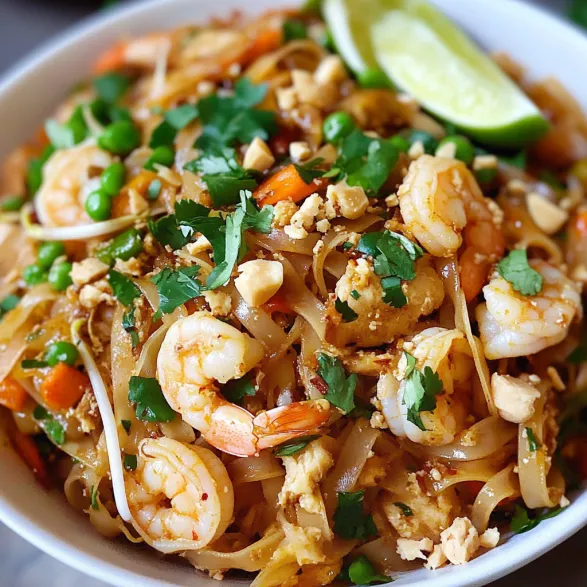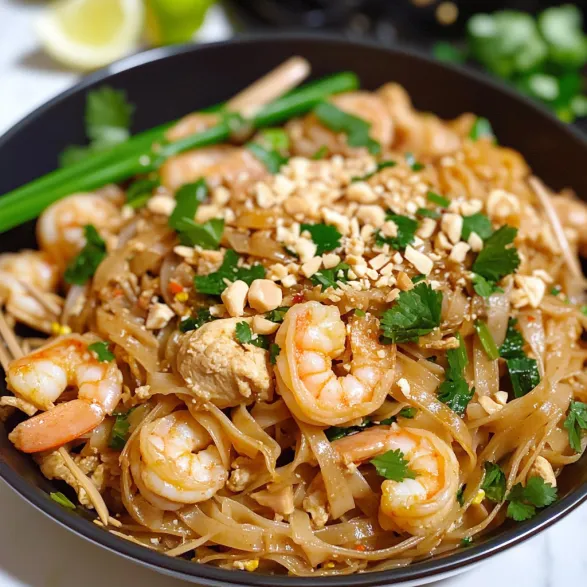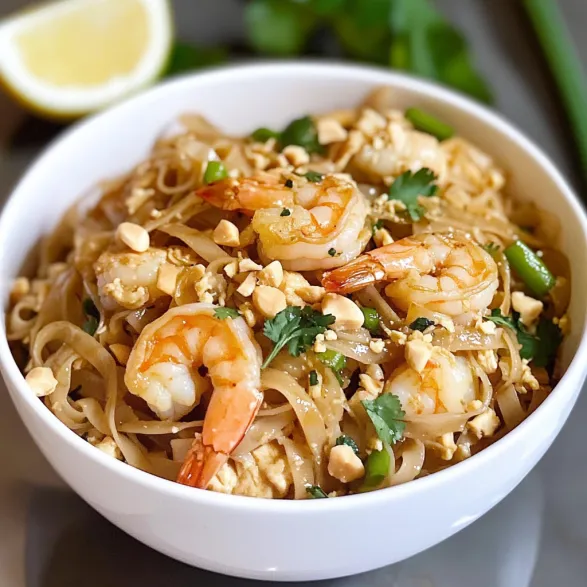 Bookmark
Bookmark
This flavorful homemade Pad Thai is a takeout favorite made better at home—tangy, spicy, and loaded with protein from both shrimp and chicken. A balanced tamarind-based sauce brings it all together with just the right punch of heat, sweetness, and umami.
I first made this recipe after returning from Thailand where I fell in love with street food Pad Thai. After much experimentation, this version now rivals my favorite Bangkok street vendor's version and has become our Friday night tradition instead of ordering takeout.
Ingredients
- Rice noodles form the foundation of authentic Pad Thai and provide the perfect chewy texture for capturing the sauce
- Tamarind paste delivers that signature tangy flavor that distinguishes real Pad Thai from imitations
- Fish sauce adds essential umami depth that cannot be substituted if you want true Thai flavor
- Chicken and shrimp offer complementary proteins and textures while making this a complete meal
- Bean sprouts provide essential crunch and freshness to balance the rich sauce
- Roasted peanuts add texture contrast and nutty flavor that completes the dish
- Fresh lime brightens everything and should never be considered optional
Step-by-Step Instructions
- Soak the Noodles
- Place rice noodles in room temperature water for 1 hour or in warm water for 10 minutes until they become pliable but still firm. This prevents them from becoming mushy during cooking. Drain thoroughly and set aside. The noodles will finish cooking in the pan.
- Mix the Sauce
- In a small bowl, combine fish sauce, soy sauce, brown sugar, tamarind paste, and hot sauce. Whisk until the sugar completely dissolves. The sauce should taste balanced between sweet, sour, salty and spicy. If it tastes too strong, remember it will distribute throughout the entire dish.
- Cook Chicken & Shrimp
- Heat oil in a wok or large skillet over high heat until it shimmers. Add chopped garlic and cook for 15 seconds until fragrant but not browned. Add chicken pieces first and cook for about 2 minutes until almost cooked through, then add shrimp and cook until they just turn pink. The high heat creates flavor while keeping the proteins tender.
- Scramble the Egg
- Push the chicken and shrimp mixture to one side of the pan creating an empty space. Add a small drizzle of oil if the pan seems dry. Crack the egg directly into the empty space and let it cook undisturbed for 30 seconds until the edges start to set. Then quickly scramble it with your spatula before incorporating it with the proteins.
- Combine Everything
- Add the soaked noodles to the pan followed by bean sprouts, green onions, and prepared sauce. Season lightly with salt and pepper. Using tongs or two spatulas, gently toss everything together ensuring the noodles get evenly coated with sauce. The noodles will absorb the sauce and continue cooking.
- Finish Cooking
- If the noodles seem too firm or the sauce too thick, add a small splash of water to create steam and continue cooking for 3–4 more minutes. The noodles should be tender but still have a slight chew. Keep tossing frequently to prevent sticking and ensure even cooking.
- Serve Immediately
- Transfer to serving plates while still hot. Top generously with chopped roasted peanuts, fresh cilantro, and arrange lime wedges on the side for squeezing. The dish should be enjoyed right away when the textures and temperatures are at their peak.
 Bookmark
Bookmark
My family particularly loves the contrasting textures in this dish. My husband always reaches for extra peanuts while my daughter doubles up on bean sprouts. I've learned to serve these garnishes on the side so everyone can customize their perfect bowl.
Perfecting Your Tamarind Sauce
Tamarind paste is the secret ingredient that gives Pad Thai its distinctive tangy flavor. If you find the paste too concentrated, mix it with a tablespoon of warm water before adding to your sauce. For those new to tamarind, start with a smaller amount and adjust to taste. Some brands vary significantly in potency, so taste as you go. I discovered this the hard way when I once used a new brand and nearly puckered my family out of dinner.
Creative Variations
Vegetarian version works beautifully by substituting tofu for the proteins and using soy sauce or coconut aminos instead of fish sauce. Press the tofu first for best texture and fry it separately until golden before adding back to the dish. For a vegan option, replace the egg with an extra quarter cup of crumbled tofu seasoned with a pinch of turmeric for color.
Ingredient Substitutions
If tamarind paste is unavailable, mix 1 tablespoon lime juice with 1 teaspoon brown sugar as a reasonable approximation. While not authentic, it provides the necessary tang. Flat linguine can substitute for rice noodles in a pinch, though the texture will differ. When fresh bean sprouts are hard to find, thinly sliced cabbage provides a similar crunch element.
 Bookmark
Bookmark
Frequently Asked Questions About Recipes
- → Can I substitute the tamarind paste?
Yes, if you can't find tamarind paste, mix 1 tablespoon of lime juice with 1 tablespoon of brown sugar as a substitute. The flavor won't be identical, but it will provide a similar sweet-sour profile that's essential for Pad Thai.
- → How can I make this Pad Thai vegetarian?
For a vegetarian version, omit the chicken and shrimp and substitute with firm tofu (about 8 ounces). You'll also need to replace the fish sauce with vegetarian fish sauce or additional soy sauce mixed with a touch of rice vinegar.
- → What type of hot sauce works best in this dish?
Sriracha is the most commonly used hot sauce for Pad Thai, but you can adjust based on your heat preference. Thai chili sauce or sambal oelek also work well. Start with less and add more to taste.
- → Can I prepare any components ahead of time?
Yes! You can prepare the sauce up to 3 days in advance and store it in the refrigerator. You can also chop the garlic, green onions, and cilantro ahead of time. The rice noodles should be soaked shortly before cooking for best texture.
- → What's the best pan to use for Pad Thai?
A wok is traditional and ideal because it distributes heat evenly and allows for quick tossing of ingredients. However, a large non-stick skillet or frying pan will also work well if you don't have a wok.
- → How can I tell when my rice noodles are properly soaked?
Properly soaked rice noodles should be pliable but still slightly firm and not completely soft. They'll continue cooking in the pan. If they're too soft before stir-frying, they may become mushy in the final dish.
